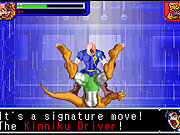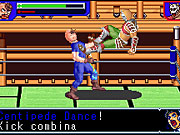If you grew up in the 1980s, you may recall a series of tiny pink wrestling figures called M.U.S.C.L.E. men. More than 200 different characters were released, but the fad faded away quietly with the onset of the 1990s, quite possibly because there wasn't an accompanying cartoon series to maintain interest in the toy line. Recently, Bandai introduced Ultimate Muscle, a new line of wrestling toys based on the original M.U.S.C.L.E. line. The marketing for Ultimate Muscle is much more pervasive than the campaign for the original series. An animated cartoon show regularly exposes children to the ongoing adventures of characters such as Kid Muscle, Terry Kenyon, and Ramen Man, and there are also accompanying video games available for the Nintendo GameCube and Game Boy Advance systems. The GBA game is titled Ultimate Muscle: The Path of the Superhero. It's a simple yet entertaining game that should appeal greatly to fans of the cartoon series.

The game features 24 individual characters and four different play modes. Like the TV show, the story mode centers on Kid Muscle, a reluctant hero living in the shadow of his father, the legendary King Muscle. As you defeat opponents in the story mode, you'll see various events unfold just as they have in the animated series. These moments are presented using comic-book-style cutscenes overlaid with textual dialogue drawn directly from the show. The other play modes include the typical one-on-one versus and survival options you've seen in other games, as well as a unique three-on-three team battle mode that's similar to what you'd find in SNK's popular King of Fighters fighting game series. Unfortunately, there isn't a tag team mode, nor is there a create-a-wrestler feature that allows you to put together your own characters. On the upside, however, every play mode other than the story mode includes link-cable support, allowing you to compete against a friend who also owns a copy of the game.
For the most part, Ultimate Muscle is easy to get the hang of, although it does take a brief amount of time to become accustomed to the game's timing system. When characters grapple, a vertical bar with a cursor and three different color zones appears. Weak moves can be pulled off when the cursor is in the yellow or blue portions of the bar, while strong moves, whips, and throws can be accomplished only when the cursor is in the blue portion. If you hesitate too long or input a command when the cursor is in the red section, your opponent will perform a move. As you wear down an opponent, the sizes of the blue and yellow portions of the bar increase, improving your chances of successfully performing an attack. Each character has his own set of roughly a dozen or so grapples and counters, although there aren't any turnbuckle or over-the-ropes maneuvers.
What separates Ultimate Muscle from other wrestling games is that you don't win matches by pinning your opponent. Instead, you have to KO your adversaries by performing signature moves when their stamina is low. You can execute a signature move when an opponent is stunned or has been launched into the air, but the timing window for performing these moves is much shorter than for normal grapples. The only time the blue area of the meter is substantial is when your opponent is completely worn out. Otherwise, you'll need to activate what's called a friendship power in order to supersize the meter. The friendship meter builds gradually every time you and your opponent come in contact, typically giving you two or three opportunities to perform signature moves during a match. Signature moves liven up the pace of a match considerably, mainly because they're accompanied by glitzy graphical effects and digitized voice clips taken directly from the cartoon series.

The cutscenes that occur between matches and when signature moves are performed help tie the video game into the cartoon series, but even the action in the ring bears striking a resemblance to the TV show. The characters are large and look exactly like they do on TV or in the toy packages, even if the animation isn't as smooth as is possible on the Game Boy Advance. Every time you perform a signature move or activate a friendship power, you'll hear the actual characters call out their moves, thanks to the use of digitized voice clips. There's even running, text-based commentary from Mac Metaphor and Doc Nakano that scrolls across the bottom of the screen. Some of the ring locations don't display much in the way of outside detail, but that doesn't detract substantially from the game's intended celluloid look.
While Ultimate Muscle: The Path of the Superhero is primarily a game for fans of the franchise, there's enough in it to appeal to enthusiasts of traditional fighting and wrestling games. The characters and their moves are positively hilarious, and the combat system is complex enough to allow two human players to play match after match without growing bored.